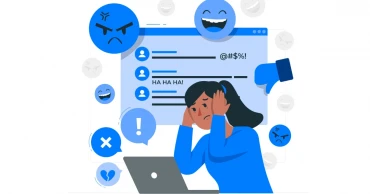mental health
Riding into the unknown: The impending mental health crisis in Bangladesh
Tears have no colour, they say. Yet in Bangladesh, countless tears fall quietly, behind closed doors, where no one notices.
A mother wakes before dawn, her chest tight with panic because sleep has once again betrayed her. A factory worker forces his trembling hands through another endless shift. A teenage girl laughs with her siblings while a storm of fear rages inside her.
These are not isolated tales of sadness. They are glimpses into the daily battles of people living with mental illness. Some carry a diagnosis. Many do not. Yet all of them shoulder conditions too often brushed aside - as weakness, as silence, as shame.
They are everywhere. But for each of them, there is almost no hand to hold, no ear to listen, no system ready to help.
The quiet siege of daily life
Numbers alone cannot tell the whole story, but they paint a grim picture.
Between 2022 and 2025, researchers surveyed more than 7,500 women in hospitals across Bangladesh. What they found was staggering: three out of four pregnant and new mothers battled depression or anxiety, and more than half suffered from both at once. For many, what should have been a time of joy turned into ‘nights of exhaustion, despair and haunting thoughts’. (Source: Dhaka Tribune)
Children and teenagers are no less burdened. An education system built on fear and finality too often crushes them. In May 2024, at least eight students died by suicide on the day their SSC exam results were released - proof that, for some, a single ‘piece of paper’ can feel like the end of life itself. (Source: Daily Observer)
Adults carry their own silent weights. Nearly one in five struggles with depression or anxiety. Yet the vast majority never receive treatment - not because they do not want it, but because it is too costly, too far away, or ‘too shameful to seek’.
In a country of more than 170 million people, there are only 260 psychiatrists and 565 psychologists - most based in cities. Rural Bangladesh, where most people live, remains abandoned in the dark.
Why the silence deepens
The last nationwide mental health survey was carried out in 2018. Since then, the country has endured the pandemic, spiralling prices, political turmoils and repeated climate disasters - each a heavy blow to already fragile minds. But no new data tells us how deep the wounds now run.
Even for those who try to seek help, barriers stand tall. Counselling often means long travel, unbearable expense and stigma that can break a person before the illness does.
Women face an added wall of silence, trapped by patriarchy and shame. Speaking about despair can invite ridicule or even abuse. For youth, failure feels final. For the poor, survival leaves no space for healing.
On paper, Bangladesh has taken steps. It has joined the WHO’s Special Initiative for Mental Health. Plans are in motion for a new Directorate of Mental Health, with promises of expanding primary care and telemedicine.
But promises are not practice. Most districts have yet to see any meaningful services. Budgets remain thin, facilities few and public awareness campaigns rare. The gap between ambition and lived reality continues to swallow lives.
What must change
Mental health is not a private weakness - it is a public issue, and ignoring it is a national failure. Experts urge:
1. Conduct national mental health surveys every 2–3 years.
2. Bring services closer - community centres, mobile clinics, school and workplace counselling, and promote tele-counselling.
3. Train and deploy more psychiatrists, psychologists, and counsellors - especially women professionals.
4. Embed mental health education into schools and workplaces.
5. Fight stigma through campaigns led by media, faith leaders, and communities.
Each unheard cry is not just an individual tragedy - it is a collective loss.
Bangladesh can choose to remain silent, becoming a country of unheard voices. Or it can choose to act — to open a clinic, to offer a listening ear, to save even one life.
Because if even one life is pulled back from despair, the story changes. And that change begins the moment silence finally breaks.
2 months ago
7 Warning Signs Social Media Is Affecting Your Child’s Mental Health
In today’s hyper-connected world, children are growing up with screens as constant companions—scrolling, sharing, and seeking approval online. While social media offers scopes of connection and creativity, its darker effects often go unnoticed. Minor shifts in behaviour, mood, and daily habits may indicate underlying emotional distress. Recognising these early warning signs is crucial to safeguarding kids’ mental health and overall well-being. Let’s look closely at the red flags that social media-addicted children may reveal, which is more than just screen fatigue.
7 Red Flags That Signal Social Media Affects Your Child’s Mental Wellbeing
.
Irritability, Anger, Anxiety, and Depression
Emotional turbulence is often one of the first signs that social networks are impacting a child’s mental well-being. A child who once handled challenges with calm may suddenly snap over minor inconveniences—like being asked to pause their screen time. This shift is more than a passing phase.
Excessive digital platform exposure can condition a kid’s brain to expect instant gratification. Consequently, it gets difficult to tolerate delays or engage in slower-paced activities like reading or studying. The flood of fast, dopamine-triggering content rewires emotional responses, often replacing patience with frustration. As a result, parents might find their child increasingly restless, easily angered, and emotionally unbalanced even outside the screen.
Read more: How to Keep Your Baby Comfortable and Healthy While Using Air Conditioner or Cooler
Losing Track of Time
When children spend long hours online, it’s easy for them to lose a sense of time. What often begins as a quick scroll can spiral into hours of passive consumption, especially on apps designed to encourage endless engagement. This disconnection from time awareness can quietly lead to neglect of daily responsibilities such as homework, family interactions, or personal hygiene.
The 2025 report from Common Sense Media reveals that children under 8 now spend an average of 2 hours and 27 minutes each day engaging with screen-based media. TikTok dominates their screen time with nearly two hours a day, making it the top platform among this age group. These numbers point to a growing trend where time management skills erode as children become immersed in the virtual world.
Social Withdrawal
As children spend more time scrolling through digital feeds, their connection with real-world interactions often begins to fade.
Social psychologist Jonathan Haidt, in his book The Anxious Generation (2024), likens social media to a firehose of addictive content. It displaces physical activity and in-person play—fundamental elements of healthy childhood development.
Read more: Summer Tips for School-going Children
Children using online media for three or more hours a day often avoid eye contact and struggle to express emotions clearly. Moreover, they speak in incomplete sentences during face-to-face interactions.
For instance, a child who once eagerly engaged in family dinners might now retreat to their room, avoiding conversation entirely. This pattern of withdrawal isn’t shyness-—it’s discomfort, shaped by a digital world that rarely demands verbal or emotional expression.
Misguided Self-esteem
Virtual communities often act as distorted mirrors, shaping how children perceive their worth. Constantly exposed to highlight reels of peers’ lives, many begin to question their own value.
According to ElectroIQ's Social Media Mental Health Statistics, 52% of users report feeling worse about their lives after seeing friends’ posts. 43% of teenagers admit feeling pressure to post content, driven by the hope of gaining likes or comments.
Read more: How to Protect Children from Electric Shocks
This chase for validation can have serious consequences. Children may develop body image issues or body dissatisfaction, comparing themselves to edited or filtered content. To gain approval online, they might resort to risky behaviour. For example, a teen might post provocative or reckless videos for attention and digital praise.
Losing Attention in Offline Tasks
Children nowadays are increasingly struggling to stay focused on tasks that require sustained concentration, like reading, studying, or completing chores. SambaRecovery's report highlighted that children’s average attention span is only 29.61 seconds. Over time, this figure showed a significant 27.41% decline during the continuous performance test.
This trend mirrors parental concerns- 79% of parents, as cited by Common Sense Media 2025, fear that heavy screen exposure is eroding their child's ability to concentrate.
This erosion is often visible in daily life. Constant notifications, videos, and scrolling content condition young minds to crave quick bursts of stimulation. It makes slow, offline tasks feel dull and unrewarding. Over time, this affects not just academics but also a child’s overall cognitive stamina and productivity.
Read more: Parenting a Teenager? 10 Tips to be Their Best Friend
Fear Of Missing Out (FOMO)
This is a powerful psychological driver that affects emotional health and can be especially damaging. This feeling stems from the perception that others are enjoying experiences, events, or interactions without them. It's amplified through the constant visibility of others’ lives online.
For example, a kid might see classmates hanging out without him/her, sparking feelings of exclusion, sadness, or even jealousy. These emotions, although silently endured, can create deep emotional turbulence. FOMO intensifies anxiety and self-doubt, fuelling compulsive social network checking as children try to stay “in the loop” at all times.
Increased Secrecy and Refusal to Go Outside
When children begin to maintain excessive secrecy, it’s often a red flag that something deeper is affecting their well-being. If your child has previously been open but suddenly becomes reluctant to share details about their day or their online activities, it could signal emotional distress. Secrecy often indicates that they are hiding something troubling, like exposure to cyberbullying or other online dangers.
According to social media mental health statistics, 87% of teens report being cyberbullied. Notably, 36.4% of girls report being affected by online harassment, compared to 31.4% of boys.
Read more: The Importance of Instilling Leadership Skills in Your Child
This constant exposure to negativity can cause children to avoid going outside, preferring the perceived safety of digital spaces. Over time, this behaviour can lead to a loss of trust and emotional isolation, as children avoid engaging in conversations.
Wrapping Up
These 7 warning signs reflect social media's negative impact on children's mental and emotional health. Excessive screen time can cause them to lose track of time and decrease their attention span, neglecting important tasks and responsibilities. Over time, this often results in social withdrawal. The constant comparison to others online fosters misguided self-esteem and worsens their mental well-being. Furthermore, children may struggle with FOMO, which heightens their feelings of inadequacy. As they struggle with these emotions, many develop increased secrecy, distancing themselves from the real world. All of these factors contribute to heightened emotional distress, often manifesting as irritability, anger, anxiety, and depression.
Read more: Bullying in School: How to Protect Children and Deal with the Issue
8 months ago
How to Recognise Your Emotional Red Flags
An emotional red flag is a warning sign or indicator that something in your emotional state, behavior, or thought patterns may require attention. These signals often suggest you're experiencing distress, discomfort, or unhealthy emotional responses that could lead to bigger issues if not addressed. Emotional red flags serve as cues for self-awareness and an opportunity to reflect on what’s happening inside your mind. Let’s find out the characteristics of emotional red flags and ways to recognize those in your behaviors.
Key Characteristics of Emotional Red Flags
.
Sudden Emotional Changes
Sudden emotional changes refer to rapid or unexpected shifts in a person’s emotional state. These changes can happen quickly, often without clear reasons, and may involve moving from one emotion to another, such as feeling overwhelmed, irritable, or sad without a clear reason.
These emotional fluctuations can be mild or intense and may occur due to various factors, including stress, anxiety, hormonal changes, mental health conditions, trauma, sleep deprivation, certain medications, etc.
Read more: How to Teach Students to Accept and Overcome Academic Failures
Recurrent Negative Thought Patterns
Recurrent negative thought patterns refer to repetitive, often automatic, and persistent thoughts that focus on pessimistic or self-critical ideas. These patterns can be distressing and are typically negative, leading to feelings of sadness, anxiety, or hopelessness. They often become habitual, meaning the person regularly experiences them without actively trying to and can affect mental well-being and behavior. Common types of recurrent negative thought patterns include:
- Constant Self-criticism: Harshly judging oneself, often engaging in self-blame or feelings of inadequacy.- Overthinking- Catastrophizing: Expecting the worst possible outcome.- Overgeneralization: Making broad, sweeping conclusions based on a single event or piece of evidence.- Black-and-white Thinking: Viewing situations in extremes, with no middle ground or shades of gray.- Negative Mental Filtering: Focusing only on the negative aspects of a situation and ignoring any positive ones.- Personalization: Blaming oneself for things outside of one’s control, or assuming responsibility for others’ actions or feelings.- Should Statements: Having rigid, unrealistic expectations about oneself or others, often leads to feelings of guilt or frustration when they aren't met.- Emotional Reasoning: Believing that negative emotions reflect objective reality.- Discounting the Positive: Downplaying or dismissing any positive feedback or accomplishments.- Mind Reading: Believing you know what others are thinking, often assuming they have negative thoughts about you.
Read more: Why are Suicide Rates Higher Among Men?
Avoidance Behaviors
Avoidance behavior refers to actions or strategies people use to prevent facing situations, tasks, or thoughts that make them feel anxious, uncomfortable, or stressed. This behavior is a coping mechanism that temporarily alleviates discomfort but can reinforce negative feelings or create long-term problems.
Essentially, avoidance serves as a way to escape or avoid an unpleasant emotional state, but it doesn't resolve the underlying issue. Over time, avoidance can become a habitual response, which can increase the severity of the problems it was meant to avoid.
Uncharacteristic Reactions
Uncharacteristic reactions refer to responses or behaviors that are unusual, unexpected, or not typical of how a person usually behaves or reacts in a particular situation, like overreacting to minor issues or withdrawing completely from social interactions. These reactions often differ from an individual’s usual patterns of behavior, emotional responses, or coping mechanisms.
Read more: Good Stress: What Are the Benefits of Eustress?
Uncharacteristic reactions can be triggered by various factors, including stress, trauma, illness, or emotional disturbances, and may represent a deviation from someone's normal ways of thinking, feeling, or acting.
Recognizing these signs allows you to pause, reflect, and take action to manage your emotions before they escalate into more significant problems.
Ways to Recognise Your Emotional Red Flags
Recognizing your emotional red flags is an essential step in maintaining emotional well-being and healthy relationships. Here’s a guide to help you identify them:
Track Repetitive Thoughts
Are you replaying the same negative or traumatic past experiences inside your mind again and again? Look for recurring negative thought patterns, such as Self-criticism, Catastrophizing, Blaming others, feeling victimized, etc.
Read more: 10 Ways to Ensure Emotional Well-being during Pregnancy
Monitor Changes in Behavior
Look into your actions. Notice when you start behaving differently, for example avoiding people or situations, overeating or undereating, losing motivation for tasks or hobbies you usually enjoy, etc.
Reflect on Past Experiences
Think about situations where you felt emotionally overwhelmed like extreme anger, panicking, grief, anxiety, joy, happiness, numbness, etc. over minor issues. What were the signs leading up to those overreacting or overwhelming moments?
Notice Emotional Outbursts
Reflect on moments when your emotions feel overwhelming, leading to sudden anger or irritability, crying unexpectedly, feeling numb or shutting down, etc.
Read more: Discomfort Anxiety v Depression: Differences, Ways of Prevention
Identify Triggers
Analyze your emotional outbursts to find the triggers. Try to recognize situations or interactions that consistently cause negative emotions inside your mind, such as certain people or environments, specific words or tones of voice, high-pressure situations, etc.
Keep a Journal
Write down your thoughts, feelings, and reactions. Over time, patterns may emerge, making it easier to pinpoint what sets off your emotional red flags.
You can maintain a paper or digital journal based on your preference. Nowadays, diverse free and paid journaling apps are found on Android and iOS.
Read more: Micro-acts of Joy: Secret to Being Happier and Healthier?
Ask for Feedback
Sometimes, those close to you may notice red flags you don’t. Ask trusted friends or family members if they observe any changes in your mood or behavior. It will help you recognize your mental issues before they get worse.
Track Physical Symptoms of Emotions
Emotions often trigger physical reactions. Notice if you experience: Increased heart rate, Tightness in the chest, Clenched fists or jaw, Feeling drained or restless, etc. These symptoms can indicate heightened emotional states like anger, anxiety, or fear.
To cope with the physical symptoms linked to emotions, consider strategies such as meditation, yoga, regular exercise, mindfulness, therapy, etc.
Read more: How to Spend the Weekend in a Creative Way
Conclusion
Emotional red flags are early warning signs that indicate you may be headed toward emotional distress or unhealthy behaviors. These signals often manifest in patterns of thought, feelings, or actions. Recognizing emotional red flags, you can understand the triggers and reasons for your sudden emotional outbursts, negative thought patterns, avoidance behavior, uncharacteristic attitudes, etc. Understanding the link between emotions and physical symptoms can help you better manage both mental and physical health.
However, identifying your emotional red flags isn’t about self-judgment but about understanding yourself better. Treat yourself with kindness as you work through your emotions. By becoming more attuned to your emotional red flags, you can take proactive steps to manage them and maintain emotional balance. Overall, this process can help you move toward the path of healing through mental health support, counseling, self-compassion, etc.
Read more: How to Enjoy Your Own Company: Tips to Overcome Loneliness
11 months ago
Cyberbullying: What to Do If Someone is Harassing You Online
Cyberbullying has emerged as a widespread concern in the contemporary digital era, as harassment across diverse online platforms has become increasingly frequent. This type of bullying poses significant threats to the mental health and overall well-being of individuals. This underscores the importance of addressing this issue promptly and effectively.
What is Cyberbullying or Cyber Harassment?
Cyberbullying, also known as cyber harassment, refers to the use of digital communication tools such as social media platforms, messaging apps, or online forums to intimidate, threaten, or harass individuals. This form of bullying encompasses various actions, including sending hurtful messages, spreading rumours, sharing embarrassing photos or videos without consent, and creating fake accounts to impersonate and harass someone.
Cyberbullying can occur anonymously, making it difficult to identify perpetrators. Also, it can have profound and lasting effects on the mental and emotional well-being of victims.
Read more: '80% of cyberbullying victims are women'
Types of Cyberbullying
Harassment
Harassment entails sending mean or threatening messages to someone online. It can be done through text messages, emails, social media posts, or online chat rooms.
Exclusion
Exclusion involves intentionally leaving someone out of an online group or activity. For instance, a cyberbully might create a social media group and exclude their target.
Outing and Doxxing
Doxxing includes sharing someone's private information online without their consent. For example, their home address, phone number, or embarrassing photos.
Read more: Online bullying serious problem for 85% of Bangladesh youths: Survey
Impersonation
Impersonation means creating a fake online profile and pretending to be someone else. The cyberbully can then use this fake profile to send mean messages or damage the victim's reputation.
Trickery
Trickery mainly is deceiving someone into sharing personal information or embarrassing photos. For example, a cyberbully might create a fake survey to obtain personal details.
Cyberstalking
This involves using technology to harass, intimidate, or threaten someone. This includes sending threatening messages or tracking the victim's online activity.
Read more: Why are Suicide Rates Higher Among Men?
Flaming
Flaming is described as posting angry or insulting messages on someone's social media page or online forum.
Trolling
Trolling entails posting inflammatory or off-topic messages in an online forum to upset other users.
Fraping
A frape happens when someone changes another person’s information on social media without them knowing or giving permission.
Read more: How to Protect Your Child from Sexual Abuse?
Impacts of Cyber Harassment
Emotional Distress
Cyberbullying can lead to profound emotional turmoil, including feelings of sadness, humiliation, and anger. Victims often experience heightened anxiety, constantly anticipating the next hurtful encounter, which undermines their sense of safety and well-being.
Psychological Effects
Research shows a significant correlation between cyberbullying and psychological challenges. Victims of cyberbullying frequently endure elevated levels of stress, anxiety, depression, and even suicidal ideation.
The relentless influx of derogatory messages and harassment often fosters sentiments of powerlessness and diminished self-worth. Also, the incessant negativity and pressure can prove overwhelming for those targeted.
Read more: Students with Depression: Tips for Parents and Educators
Social Isolation and Self-Esteem Damage
Cyberbullying can cause individuals to retreat from both online and offline social interactions, fearing additional harassment or scrutiny from their peers. This can foster feelings of isolation and solitude. Additionally, cyberbullying can profoundly impact an individual's self-esteem, as the recurrent attacks can engender feelings of worthlessness and insecurity.
Academic Consequences
The emotional distress caused by cyberbullying can impact victims' ability to concentrate on their studies and perform academically. Consequently, this can lead to a decline in grades and overall academic performance of the bullied person.
Physical Health Issues
The prolonged stress and anxiety caused by cyberbullying can manifest in physical health problems such as headaches, insomnia, and gastrointestinal issues. Victims may also experience changes in appetite and energy levels.
Read more: Digital Detox: Unplugging for Stress Relief and Mental Wellbeing
Long-term Effects
The effects of cyberbullying can extend beyond the immediate harassment, affecting victims' long-term mental health and well-being. Some individuals may carry the trauma of cyberbullying into adulthood, impacting their relationships and overall quality of life.
Bystander Effects
Observing cyberbullying can exacerbate mental health issues and foster an atmosphere of apprehension and vulnerability. It can instil fear of becoming a target, erode trust in online interactions and impact individuals' well-being.
What to do If You Experience Cyberbullying in Bangladesh
Stay Calm
It is essential to maintain composure and refrain from impulsive reactions to harassment. Responding to the bully may exacerbate the situation, as it gratifies their desire for a reaction. So, try to resist the temptation to engage with their messages or posts.
Read more: Helicopter Parenting: Signs, Pros, Cons and How to Change
Document Evidence
It is important to document instances of cyberbullying, whether through screenshots of messages or posts or by noting down dates and times. This evidence will prove invaluable should you need to report the bullying at a later stage.
Reach Out for Support
It is highly recommended to discuss your experiences with a reliable friend, family member, another trusted adult, or mental health professional. They can provide valuable support and advice on navigating through the situation effectively.
Block the Bully
You may utilise privacy settings to block the person responsible for the harassment from reaching out to you further. Most social media platforms and messaging apps offer the option to block individuals. It can effectively prevent any further contact with them.
Read more: Workplace stress affecting women in Bangladesh needs attention
Report the Abuse to the Platform
Utilising the available reporting tools to report instances of cyberbullying is crucial. Most social media platforms and online forums provide mechanisms for reporting abusive behaviour. Report the cyberbullying to the relevant website or platform, as they typically have anti-bullying policies and may take disciplinary action against the perpetrator, such as suspending their account.
Seek Legal Advice
In instances of severe cyberbullying, it is advisable to seek advice from a legal professional. The available remedies for cyberbullying may vary depending on individual circumstances. Victims are advised to seek legal counsel from a lawyer knowledgeable about cyberbullying and relevant laws for guidance.
File a Report
Victims of cyberbullying have the option to file a criminal complaint with the police under the Cyber Security Act of 2023. This act criminalises cyberbullying and imposes imprisonment and/or fines on offenders found guilty.
Read more: Parliament passes Cyber Security Bill 2023
Cyber Crime Help Desk
Bangladesh Police operates a Cyber Crime Help Desk for women (https://www.police.gov.bd/en/police_cyber_support_for_women) where victims can report incidents of cyberbullying and seek assistance. Evidence and proof (links, screenshots, etc) of cyberbullying can be forwarded via email to [email protected]
Also, victims can lodge complaints through multiple channels, including the dedicated hotlines at the Police Headquarters, the nearest police station or the official Facebook page of "Cyber Police Centre, CID, Bangladesh Police."
Alternative Reporting
Cybercrime victims also have the option to file complaints with the Bangladesh Telecommunication Regulatory Commission (BTRC) by calling their hotlines or emailing [email protected].
Read more: Sibling Bullying and Abuse: Reasons, Types, Signs and Prevention
BTRC pledges to take action within 24 hours, with perpetrators brought to justice within 3 days of filing the complaint. The government has also introduced a cyber-crime helpline at +88-02-55007183 for victims to report their complaints.
Consider Civil Suit
Victims can pursue a civil suit for damages against the perpetrator, seeking compensation for emotional distress and reputation damage caused by cyberbullying. In cases of criminal intimidation, the perpetrator may be liable under the Penal Code 1860.
Seek Restraining Orders
Although the term "restraining order" is not specifically defined in Bangladesh’s law, victims can apply under relevant sections before a competent executive magistrate to prohibit a perpetrator from making unlawful contact.
Read more: Should You See a Therapist? 8 Surefire Signs You Need Help
Take Care of Yourself
The emotional strain of cyberbullying can impact your mental well-being. You should prioritise self-care by reaching out to loved ones, participating in activities that bring you joy, and seeking professional assistance if necessary. Concentrate on self-nurturing activities to alleviate stress during this demanding period.
Verdict
Cyber harassment is a serious issue that can have profound consequences on individuals' lives. It is crucial to recognise the signs of cyberbullying, take proactive measures to protect oneself and seek support if victimised. By working together to combat cyberbullying, we can create safer and more inclusive online communities.
Read more: Bullying in School: How to Protect Children and Deal with the Issue
1 year ago
Why are Suicide Rates Higher Among Men?
Suicide is a tragic and complex phenomenon that affects individuals and communities worldwide. Mental health negligence, particularly concerning men, has become a pressing concern. Despite increasing awareness of mental health issues, men often face unique challenges that make them more vulnerable to suicide. This article delves into the various factors contributing to this troubling trend.
Global and Local Statistics of Suicide: Male vs Female
Females, especially those under 25, exhibit higher rates of non-fatal suicidal behaviour and suicidal ideation, and attempt suicide more frequently. But, in reality, males have a significantly higher rate of completing suicide than females. This phenomenon is commonly known as the gender paradox in suicide.
Around the world, more men than women die by suicide. According to Wikipedia, in 2008 and 2015, the number of male suicides was about 1.8 to 1.7 times higher than female suicides globally. In Western countries, men are three to four times more likely to die by suicide compared to women. In 2015, around two-thirds of global suicide deaths (representing about 1.5% of total deaths) were among men.
Data from The National Violent Death Reporting System (NVDRS) in the USA for 2016 revealed that for every female suicide, there were about 3.5 male suicides. However, in China, the rates of suicide between men and women were almost the same. The male vs female suicide ratio is 9.1:10.3.
Read more: Good Stress: What Are the Benefits of Eustress?
In 2019, the rate of suicide deaths among males was over 3.5 times higher than that among females. By 2021, this disproportionate rate increased to over 3.9 times higher.
According to the CDC, in the USA, men experienced a suicide rate four times higher than that of women in 2021-2022.
In Bangladesh, the scenario is quite the same – more men than women commit suicide here. In 2017, there were over 11,000 recorded suicides. The average age for male suicide victims was about 28.86 years, while for females, it was about 25.31 years old.
In 2019, 3.70 people took their own lives out of every 100,000 people in Bangladesh. The male suicide rate was 5.70 while the number is 1.70 for females. Also, the police records indicate a rising trend in suicides over the years. At the same time, psychologists estimate that around 11,000 people end their lives annually in Bangladesh.
Read more: Students with Depression: Tips for Parents and Educators
1 year ago
Good Stress: What Are the Benefits of Eustress?
Nowadays everyone is talking about the goal to get a stress-free life. Stress is a familiar term in today's busy world. We often associate it with negative effects on our mental and physical health. But actually, not all stress is detrimental. There is a positive side to moderate stress. This is known as good stress and this can be beneficial for us.
What is Positive Stress or Eustress?
Good stress, known as eustress, is the kind of stress that makes people feel excited and motivated. It is like a little challenge that helps one do one’s best.
Eustress can encourage an individual to try a new hobby, learn a new language or skill, and even step outside one’s comfort zone.
For instance, a school student, Mina, had to participate in a spelling competition. She felt a bit nervous but also eager to do her best. The stress motivated her to study hard and concentrate. During the competition, her heart was racing, but she remembered the words and won! The good stress she felt had pushed her to succeed.
Another example, giving a speech at a seminar might make an individual nervous, but it is also exciting for him or her.
This mix of feelings is good stress or eustress. It pushes people to prepare and focus.
Read more: Students with Depression: Tips for Parents and Educators
Difference between Good Stress and Bad Stress
Good stress, like starting a new job or preparing for a race, is like a little push that makes you excited. It helps you to focus and do your best. It is like a friend cheering you on!
Bad stress, on the other hand, is like a big heavy weight on one’s shoulders. It is when things feel tough and overwhelming, like money troubles, anxiety regarding academic performance or worrying about career issues, etc. Such stresses are also called negative stress or distress. Distress can make one feel tired and worried all the time.
Therefore, the difference between good stress and bad stress is obvious. Eustress is like a friendly nudge that helps you, while distress is like a big rock that's hard to carry. It is important to manage bad stress, maybe by talking to someone, getting counselling, finding ways to relax, doing yoga, or similar stress-relieving activities. It should be ensured that negative stress does not weigh anyone down too much.
Read more: 10 Ways to Ensure Emotional Well-being during Pregnancy
2 years ago
Students with Depression: Tips for Parents and Educators
Depression among students is a critical issue that demands urgent attention. The gravity of this problem magnifies the alarming rise in dropouts from colleges, study breaks, drug addictions, even suicidal attempts among students. As parents and educators, it is essential to be proactive in addressing this crisis through understanding, support, and guidance. Let’s take a look into how to prevent depression in students.
Common Reasons for Depression among Students
Depression among students can be attributed to various factors, and understanding these reasons is the first step in prevention. Here are some common causes:
- High expectations and academic stress can lead to feelings of hopelessness
- Loneliness and a lack of social support can make students vulnerable to depression and suicidal thoughts
- Bullying, whether in person or online, can devastate a student's mental health
- Drug or alcohol abuse can exacerbate depression and increase the risk of suicide
- Relationship problems can be a major source of stress and anxiety for students
- Conflict with their parents, siblings, or friends can make them isolated and alone
- Economic constraints and worries about the future can take a toll on a student's mental health
- Traumatic events during childhood, like physical or emotional abuse or loss of a parent increase the risk of depression
- Mental health conditions, such as bipolar disorder, and anxiety disorder can trigger depression
- Having certain personality traits, such as low self-esteem or being overly dependent, self-critical, or pessimistic is a reason for depression.
Read more: Protecting Your Child’s Mental Health: 10 Tips for Parents
2 years ago
Sibling Bullying and Abuse: Reasons, Types, Signs and Prevention
Bullying is a major concern that spans age and settings, sparing no space from its reach. Usually, bullying is connected with school and online spaces. We often forget other bullying behaviors like sibling bullying and abuse. In this article, we will explore the causes behind sibling bullying, its diverse forms, red flags to pay attention to, and most importantly, effective strategies for parents to both avert and tackle such conduct.
Common Reasons for Sibling Bullying and Abuse
- Jealousy and competition
- Power imbalance
- Modeling behavior
- Lack of communication skills
- Copying parental behavior
- Seeking attention
- Personal insecurities
- Unresolved conflicts
- External stressors.
Read more: Bullying in School: How to Protect Children and Deal with the Issue
Types of Sibling Bullying and Abuse
Physical Bullying
Physical bullying entails employing force or aggression to intimidate or cause harm to a sibling. This can include hitting, pushing, kicking, or any other physical actions intended to exert control or cause physical pain.
Psychological Bullying
Psychological bullying is a subtle yet damaging form of abuse where one sibling manipulates another's emotions, self-esteem, and perceptions. This can involve tactics like spreading rumors, exclusion, and using psychological pressure to gain control or dominance.
Sexual Bullying
Sexual bullying involves inappropriate and coercive behaviors of a sexual nature between siblings. This can encompass unwanted advances, comments, or actions that create a hostile environment, causing emotional distress and violating personal boundaries.
Read more: How to Raise a Caring, Empathetic and Compassionate Child
Symptoms of Sibling Bullying and Abuse
- Unexplained marks or bruises
- Frequent feelings of unease
- Marks from self-harm or expressing thoughts of self-harm
- Decline in school performance
- Fear or anxiety around a particular sibling
- Rapid fluctuations due to stress
- Refusal to be alone with the sibling
- Low self-esteem
- Running away from home
- Sleep disturbances or changes in sleep patterns
- Inappropriate sexual behavior.
Read more: Common Sleep Problems in Children: Causes, Symptoms, Ways to Help
Effects of Sibling Bullying and Abuse on Children’s Mental Health
- Diminished confidence and self-worth
- Triggering depression
- Anxiety due to fear
- Social isolation
- Trust issues
- Internalized aggression
- Decline in concentration and grades
- Potential engagement in self-destructive behavior
- Eating disorders
- Effects can extend into adulthood.
Read more: 15 Gift Ideas for a Newborn Baby
How Parents can Protect Children from Sibling Bullying and Abuse
Set Clear Boundaries
Try to establish firm rules that unequivocally condemn any form of aggressive behavior or bullying between siblings. Communicate consequences for crossing these boundaries, reinforcing the importance of respect and kindness.
Positive Reinforcement
Parents should acknowledge and reward instances of respectful interactions and cooperation between siblings. This encourages a culture of kindness and reinforces the benefits of treating each other with respect.
Model Respectful Behavior
It is important to demonstrate kindness, empathy, and respectful communication in parents' interactions with others, including their children. Children often learn by example, and seeing respectful behavior from adults sets a powerful precedent for sibling interactions.
Read more: How physical punishment affects children and alternative ways to discipline them
Individual Attention
Parents should spend quality time with each child. This helps build strong bonds and reduces feelings of rivalry. It also fosters a sense of belonging, decreasing the likelihood of resorting to bullying for attention.
2 years ago
Digital Detox: Unplugging for Stress Relief and Mental Wellbeing
In today's hectic urban life, stress has become a constant companion, affecting our mental wellbeing. Research suggests that information overload, constant digital connectivity, unlimited screen time and heavy use of tech devices can lead to issues such as sleep problems, depression, and increased stress levels. Amidst such situation, digital detox can help to refresh the mind and help find moments of tranquility.
A digital detox is a personal choice to temporarily disconnect from digital devices and social media. Taking a break from screens and unplugging from the online world can provide a much-needed escape from the overwhelming digital noise. Let's explore the ways of embracing a digital detox for a rejuvenated mind.
11 Ways to Unplug Temporarily from the Digital World
Set Screen-free Zones
Consider setting up designated screen-free zones in your home. Like the dining table or bedroom, as peaceful havens for unwinding and enjoying precious moments with your close ones. By creating these spaces, you can foster relaxation, encourage meaningful connections, and cherish quality time without the distractions of screens. Let these areas become sanctuaries of togetherness and tranquility in your home.
Read more: Protecting Your Child’s Mental Health: 10 Tips for Parents
Prioritize Real-world Connections
You can schedule frequent face-to-face meetings and outings with your loved ones. These moments hold immense value in nurturing deep connections and decreasing our dependence on virtual interactions. Engaging in real-life interactions allows us to have authentic conversations, shared experiences, and a sense of closeness that cannot be replicated online.
Set Tech-free Hours
You can try to set aside specific hours each day for complete disconnection from digital devices. During this time, give yourself the opportunity to engage in activities that bring you joy, such as reading a book, exercising, or pursuing your favorite hobbies. You can create a space for personal growth, and the fulfillment that comes from offline experiences. You can embrace this valuable time to nourish your mind, body, and soul.
2 years ago
Paws for healing: How dogs aid mental health therapy in China
Following a successful six-month probationary period, a mental health center in Chengdu, the capital of southwest China's Sichuan Province, has officially welcomed two dogs to carry out psychological assistance therapy through animals.
The dogs are part of the animal-assisted therapy (AAT) in the treatment process for emotionally disturbed patients carried out by the Fourth People's Hospital of Chengdu. This marks the first time that AAT has been implemented in southwest China, and highlights the hospital's innovative approach to mental health treatment.
According to Chen Jiajia, who works with the hospital, the two dogs, "Lidabao" and "Xuegao," were previously employed in nursing homes for seniors and orphanages before joining the hospital.
The dogs used in the treatment have been carefully selected from among family pets that have undergone specialized training to develop strong bonds with humans.
Given that they reside with their owners, the therapy dogs are expected to introduce a welcoming and serene ambiance to the treatment process and the dog owners are also allowed on the site.
Having passed rigorous evaluations, both dogs were granted official working certificates and currently provide treatment twice a week.
"AAT has proven to be a successful method for treating depression and autism, and has been extensively employed in treatment programs overseas, aiding in the recovery of patients," Chen said.
Chen went on to share that earlier in January, a severely depressed boy, who didn't talk to anyone and even left a death note, took part in the trial treatment. During their initial encounter, the dog seemed to sense his depression as it instinctively nestled into his arms.
The boy who never showed his emotions couldn't hide his surprise, and later shared his story about himself and his pet, Chen explained.
The profound experience with the dog had a transformative effect on the boy's emotional state, leading him to open up to the psychologists and engage wholeheartedly in his treatment. As a result, he made remarkable progress and was eventually discharged from the hospital with a newfound sense of hope and optimism.
According to Chen, the interaction between patients and dogs can be instrumental in helping patients open up emotionally, and this process is further facilitated by the participation of psychologists who provide timely counseling and treatment.
During treatment, psychologists will give careful attention to what the patient is saying in order to identify any topics of interest. By establishing a genuine and trusting relationship with each patient, the psychologists can eventually create a supportive environment that is conducive to follow-up psychotherapy.
The hospital said treatment frequency will be adjusted according to each patient's needs and response to therapy, with the goal of providing more effective care for a greater number of patients
2 years ago



















